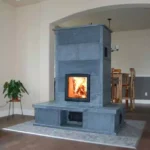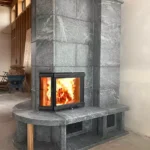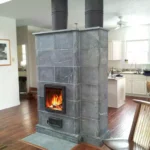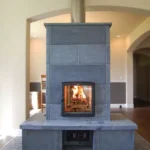Radiant Vs Convection Heat
Why will a masonry heater reduce the amount of wood, oil, gas or propane that you have burned in the past and make your home feel more comfortable? There are several variables that will impact the reduction in the energy required from your secondary heating system after installing a masonry heater. A direct line of sight from the masonry heater to each area of your home is very important. As a radiant heating device a masonry heater is very effective in heating areas within a direct line of sight, but much less effective in heating those spaces that are separated by one or more walls. The reasons are very similar to the explanation behind why it is so much harder to stay warm in most homes during the winter… even though the inside air temperature is the same 68 degrees that it is in the summer. The following aims to explain this phenomena and how radiant masonry heaters can help eliminate this problem, while lowering your heating fuel costs.
The vast majority of heat transferred into the home from a masonry heater is transferred as infrared radiant energy. Radiant heat passes through the air and warms the solids in the home directly. The air is then warmed by passing over the solids. On the other hand, traditional American heating systems including gas forced air, electric baseboard, wood stoves and fireplaces, all heat through convection heat. The electromagnetic wavelength of convection energy causes it to heat the air directly, which in turn will indirectly heat the solids in the room.
The term mean radiant temperature (MRT) is used to describe the radiant temperature of a room where all objects within the space, including walls, floor and ceiling, are emitting and receiving sufficient radiation to sustain their heat loss. The human body will reach thermal equilibrium depending on the heat balance of the body and its environment. MRT and air temperature combine to achieve a heat balance and are largely dependent on each person’s metabolic rate.
The Raber-Hutchinson comfort equation theorizes the temperature of ambient air plus the mean radiant temperature of surrounding surfaces will equal 140 degrees Fahrenheit. In other words, if the MRT is 70º F, the air temperature must also be 70º F to maintain comfortable conditions. And for every degree drop in MRT the room temperature must increase by one degree to maintain comfort for the people in the room. This also explains why you can be comfortable in your home in the summer time wearing a t-shirt, with 68 degree air temperatures, while in the winter time you can be cold in the same room with 72 degree air temperatures, while wearing a sweater. The radiant energy of the sun is stronger in the summer, which raises the MRT for all the solids that make up your home.
Similarly, a masonry heater directly heats the solids (including the people), increasing the MRT in your home, allowing you to be comfortable at lower ambient air temperatures. Since convective heating devices do little to raise the temperature of the solids in the room, the air temperature must be higher to keep its inhabitants comfortable. This variable is magnified when considering the many poorly insulted and leaky homes built throughout the United States over the last 50 years.
Many modern homes are designed around a heat loss calculation and a resulting BTU per hour input requirement. Radiant heating systems are normally sized at a lower input capacity when compared to convection heating due to the different mode of heat transfer, higher MRT, thermal mass, minimal difference between ceiling and floor temperatures and the windchill effect of convective heat. Our experience and industry wide testing shows that the BTU per hour requirement for a space with a radiant masonry heater will be on average 20-30% lower than the same space with a convection heating system. However, this applies only to the area of the home within a direct line of sight of the masonry heater. The input capacity for areas of the home not within a direct line of sight of the heater should not be reduced. Furthermore, a masonry heater placed near an exterior wall of the home can lose up to 40% of its BTU capacity for the side of the heater facing the wall. Only a masonry heater placed centrally within a space will achieve the maximum MRT increase and energy input requirement reduction.
The third type of heat transfer is conduction. Many of our clients find that the quickest way to warm up after being outside on a cold winter day is to take advantage of their masonry heater’s conductive heat transfer by sitting on the heated bench and warming their back against the side wall…
All of this explains why traditional convective heating devices are inherently inefficient. It is impossible to predict a fuel reduction rate for any particular home without doing an thorough and detailed study of the space, structure and heating systems. However, our experience with many previous customers replacing wood stoves and forced air systems, has resulted in a 40-75% reduction in secondary heating system fuel consumption.
How does radiant heat support better health? First, it fosters better circulation in the body, which promotes healing. It also encourages better respiration, a stronger immune systems and better metabolisms.
As we generally have fewer colds or flu in the summer due to the increased light and radiation from the sun, having radiant heat all year long increases this living environment. Because masonry heaters are radiating heat instead of having any form or air circulation or movement there is also a significant decrease in allergies and particles moving in the air. The radiant heat provided also does not dry out the air which results in less potential repertory ailments such as asthma, bronchitis, sinusitis and nosebleeds. This will also reduce eye and skin irritation.
Radiant heat provides a similar environment, as the sun’s rays warming the earth in the spring, which promotes a healthier environment in which to live. Conventional wisdom holds that frequent, dramatic temperature changes are hard for the body to adjust to. In Colorado, that’s exactly what we experience and meteorologists refer to our climate as harsh. It is harsh on the people who live here as well as the plants and trees. Delicate vegetation does not survive here on its own. Convection heaters produce draftiness and uneven temperatures which can leave one feeling decidedly uncomfortable. Temperatures are substantially warmer at the ceiling, while the area near the floor can be quite cool, as well as our feet. No wonder we love our warm slippers in the winter! We also run our humidifiers, especially in the fall and winter after we have turned our furnaces on. The furnace dries out the air and circulates last season’s dust and pollens around our homes. The humidifiers not only add moisture to the dry air, the water molecules tend to attach to the dust and allergens to pull them to the floor or the furniture!
Just imagine the radiant heater. Its thermal mass keeps slowly giving off its gentle heat and the room is warmed pretty evenly, so the floor isn’t dramatically cooler than the ceiling. It doesn’t dry out the air. It doesn’t circulate dust, pollen or anything else throughout the room irritating those with sensitivities. One beauty of radiant heat is that you have a much greater temperature range that is comfortable because the radiant heat is not just warming the air, but everything in the room! The heater doesn’t burn you if you touch it because the surface temperature is about 150°F to 170°F, although possibly somewhat higher around the fuel door. If the heater is fired properly, the heat is radiated rather evenly throughout the day and night. Your body doesn’t have to adjust to dramatic changes in warmth or cold throughout the course of a day because there is no need to.
We hope this helps you understand the wonder of radiant warmth and health delivered by a Greenstone Masonry Heater. Please call or email us today to discuss your project.
Discover the benefits of safe, comfortable, allergy reducing wood heat
 While convection heaters produce draftiness circulating dust, dirt and even molds and mildew throughout the heated area, radiant heat provides even temperatures from floor to ceiling. It works on the same principle as the sun does warming the earth on a calm spring day. I am reminded of a conversation I had with a chiropractor about a dozen years ago. I had been in an auto accident and received a whiplash injury from another auto hitting me from behind. This happened in the fall of the year. During the winter I commented to the doctor that I was concerned that it was taking so long to heal from the injury. He replied, wait until spring when the sun comes back and you will heal very quickly. I waited rather impatiently until spring came and his advice proved to be right on! Within a few weeks I was substantially improved and my visits to his office dropped dramatically.Radiant heat provides a similar environment, as the sun’s rays warming the earth in the spring, which promotes a healthier environment in which to live. Conventional wisdom holds that frequent, dramatic temperature changes are hard for the body to adjust to. In Colorado, that’s exactly what we experience and meteorologists refer to our climate as harsh. It is harsh on the people who live here as well as the plants and trees. Delicate vegetation does not survive here on its own. Convection heaters produce draftiness and uneven temperatures which can leave one feeling decidedly uncomfortable. Temperatures are substantially warmer at the ceiling, while the area near the floor can be quite cool, as well as our feet. No wonder we love our warm slippers in the winter! We also run our humidifiers, especially in the fall and winter after we have turned our furnaces on. The furnace dries out the air and circulates last season’s dust and pollens around our homes. The humidifiers not only add moisture to the dry air, the water molecules tend to attach to the dust and allergens to pull them to the floor or the furniture!
While convection heaters produce draftiness circulating dust, dirt and even molds and mildew throughout the heated area, radiant heat provides even temperatures from floor to ceiling. It works on the same principle as the sun does warming the earth on a calm spring day. I am reminded of a conversation I had with a chiropractor about a dozen years ago. I had been in an auto accident and received a whiplash injury from another auto hitting me from behind. This happened in the fall of the year. During the winter I commented to the doctor that I was concerned that it was taking so long to heal from the injury. He replied, wait until spring when the sun comes back and you will heal very quickly. I waited rather impatiently until spring came and his advice proved to be right on! Within a few weeks I was substantially improved and my visits to his office dropped dramatically.Radiant heat provides a similar environment, as the sun’s rays warming the earth in the spring, which promotes a healthier environment in which to live. Conventional wisdom holds that frequent, dramatic temperature changes are hard for the body to adjust to. In Colorado, that’s exactly what we experience and meteorologists refer to our climate as harsh. It is harsh on the people who live here as well as the plants and trees. Delicate vegetation does not survive here on its own. Convection heaters produce draftiness and uneven temperatures which can leave one feeling decidedly uncomfortable. Temperatures are substantially warmer at the ceiling, while the area near the floor can be quite cool, as well as our feet. No wonder we love our warm slippers in the winter! We also run our humidifiers, especially in the fall and winter after we have turned our furnaces on. The furnace dries out the air and circulates last season’s dust and pollens around our homes. The humidifiers not only add moisture to the dry air, the water molecules tend to attach to the dust and allergens to pull them to the floor or the furniture!
Just imagine the radiant heater. Its thermal mass keeps slowly giving off its gentle heat and the room is warmed pretty evenly, so the floor isn’t dramatically cooler than the ceiling. It doesn’t dry out the air. It doesn’t circulate dust, pollen or anything else throughout the room irritating those with sensitivities. One beauty of radiant heat is that you have a much greater temperature range that is comfortable because the radiant heat is not just warming the air, but everything in the room! The heater doesn’t burn you if you touch it because the surface temperature is about 150°F to 170°F, although possibly somewhat higher around the fuel door. If the heater is fired properly, the heat is radiated rather evenly throughout the day and night. Your body doesn’t have to adjust to dramatic changes in warmth or cold throughout the course of a day because there is no need to.





 How does radiant heat support better health? First, it fosters better circulation in the body, which promotes healing. It also encourages better respiration, a stronger immune systems and better metabolisms.As we generally have fewer colds or flu in the summer due to the increased light and radiation from the sun, having radiant heat all year long increases this living environment. Because masonry heaters are radiating heat instead of having any form or air circulation or movement there is also a significant decrease in allergies and particles moving in the air. The radiant heat provided also does not dry out the air which results in less potential repertory ailments such as asthma, bronchitis, sinusitis and nosebleeds. This will also reduce eye and skin irritation.
How does radiant heat support better health? First, it fosters better circulation in the body, which promotes healing. It also encourages better respiration, a stronger immune systems and better metabolisms.As we generally have fewer colds or flu in the summer due to the increased light and radiation from the sun, having radiant heat all year long increases this living environment. Because masonry heaters are radiating heat instead of having any form or air circulation or movement there is also a significant decrease in allergies and particles moving in the air. The radiant heat provided also does not dry out the air which results in less potential repertory ailments such as asthma, bronchitis, sinusitis and nosebleeds. This will also reduce eye and skin irritation. Contra: Against or contrary. Flow: To issue or move in a stream. Circulate. Then, what is a contraflow design? Well, in a masonry heater it is referring to the route the heat takes as it moves through the heater. Simply put, if left to itself, heat tends to rise. In a masonry heater, the heat rises, then goes down through a masonry channel and then rises again to the chimney where it exits the heater. So, think up, down, up again, and in some cases it can also include around. The around portion can occur when a warmed bench is included in the design.The importance of the contraflow design is evident. It allows the entire masonry portion of the heater to warm. In turn, the masonry radiates the heat into the surrounding area in a gentle manner. Radiant heating and the contraflow design does not tend to dry out the air, your nasal passages or your skin, as a convection heater does.
Contra: Against or contrary. Flow: To issue or move in a stream. Circulate. Then, what is a contraflow design? Well, in a masonry heater it is referring to the route the heat takes as it moves through the heater. Simply put, if left to itself, heat tends to rise. In a masonry heater, the heat rises, then goes down through a masonry channel and then rises again to the chimney where it exits the heater. So, think up, down, up again, and in some cases it can also include around. The around portion can occur when a warmed bench is included in the design.The importance of the contraflow design is evident. It allows the entire masonry portion of the heater to warm. In turn, the masonry radiates the heat into the surrounding area in a gentle manner. Radiant heating and the contraflow design does not tend to dry out the air, your nasal passages or your skin, as a convection heater does.